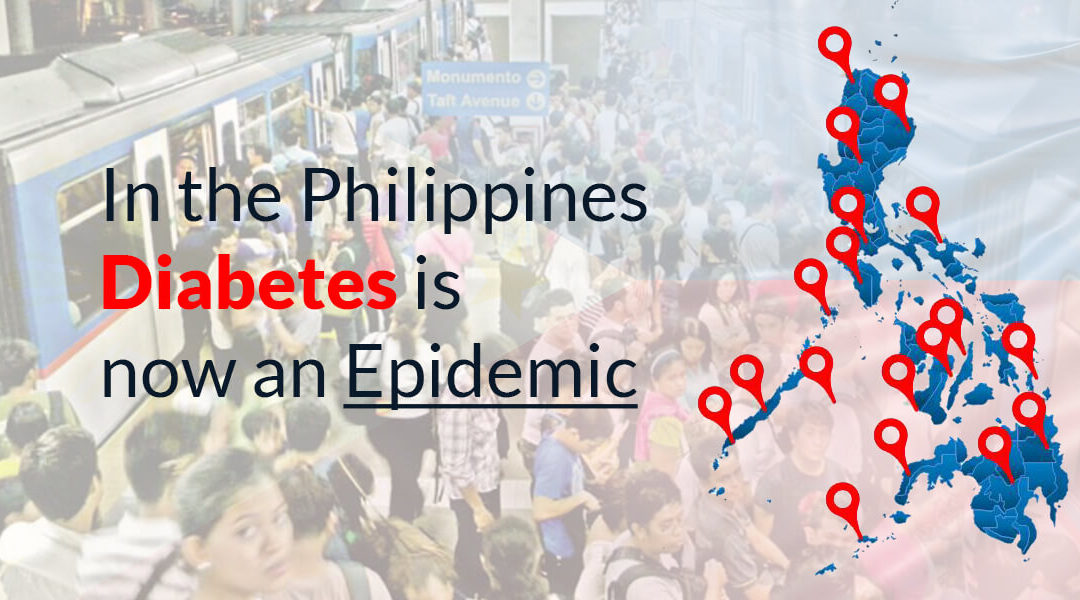At the moment, approximately 6% of the total population of the Philippines or 6 million Filipinos have been diagnosed as diabetic. Adding to this alarming number is the fact that for every diagnosed diabetic in the Philippines, there is one that does not know yet that they are diabetic.
Truly, diabetes is now an epidemic in the Philippines.
Situation in the ground

High blood sugar is not just a scourge in name or in statistics. According to Dr. JM Co, the chairman of the Department of Medicine of the University of the East – Ramon Magsaysay Memorial Medical Center Inc. (UERMMCI), diabetes is also the leading cause of blindness and kidney failure in the Philippines.
“It destroys many of the organs in our body. It’s the No. 1 cause of blindness, the No. 1 cause of kidney failure that leads to dialysis and transplants. It destroys or blocks the blood vessels in the heart, in the brain, and in the legs, so that the risk of getting a heart attack or stroke, or leg amputation, is much higher than that of a person without diabetes.” pointed Co.
Indeed, high blood sugar can cause irreparable damage to blood vessels. Once damaged, these blood vessels would then be unable to deliver nutrients and oxygen to the body’s cells and nerves. The deprivation of nourishment for these cells and nerves then affect the organs that they are part of, causing kidney failure or a host of cardiovascular diseases.
Complications

While having a high blood sugar level is not fatal in itself, the complications that arise from this condition are sufficiently dangerous, even fatal in the long run. Some of the complications of high blood sugar are the following:
- Cardiovascular diseases – Includes heart attack, stroke, atherosclerosis, and coronary heart disease with angina or chest pain. These diseases stem from the damage inflicted on the body’s blood vessels by the excess amount of blood sugar present.
- Nerve damage – deprived of nourishment, the nerves send distressed signals from your hands and feet, leading to numbness or tingling sensation in your extremities. The pain can be mild at first but gradually rises in intensity depending on your blood sugar level.
- Kidney damage – The damage that your blood vessels take from all the excess sugar will then be translated to damage on the vital organs that those blood vessels service. An example of this is the kidneys. The excess sugar will also cause disruption in the kidney’s filtering system, damaging it beyond repair.
- Eye damage – The damage wrought on the blood vessels by the excess blood sugar will also manifest itself in the retina of the eyes. There are little blood vessels here too and an excess in blood sugar in them can cause blindness, glaucoma, and cataracts.
- Foot damage – An excess of blood sugar can cause poor blood flow to the feet. Once this happens, the risk of foot diseases also increases. Wounds and cuts would heal slowly or not at all, becoming gangrenous. This can lead to amputation.
- Skin diseases – High blood sugar can also make your skin more at risk to skin infections, primarily those that are bacterial and fungal in nature. These include boils, carbuncles, folliculitis, and infections around the nails.
Diagnosing diabetes

Alongside a particularly high blood sugar level, diabetes can manifest itself in the following symptoms:
- Extreme feeling of hunger (even while you’re eating)
- Frequent urination
- Feeling very thirsty
- Extreme fatigue
- Sudden weight loss or weight gain
- Blurry vision
- Tingling, pain, or numbness in your hands or feet
- Wounds or cuts are slow to heal
If you exhibited the symptoms above, you should immediately see your doctor to get tested. This is more pressing if you have the following risk factors:
- You’re overweight or obese
- Have a family history of diabetes
- You have high blood pressure
- You’re not exercising regularly/physically active
- Have a family history of heart disease or stroke
- Have polycystic ovary syndrome (PCOS)
For testing, you can ask your doctor which test to take to determine if you’re really diabetic. You can take the Glycated Hemoglobin (A1C) test, Fasting Blood Sugar (FBS) test, Oral Glucose Tolerance Test (OGTT), and the Random Plasma Glucose (RPG) test.
Diabetes treatment

Knowing that this condition has no cure might seem like the end of the world, but it’s not. The lack of any “cure” doesn’t negate the fact that there are ways that you can do to manage your high blood sugar. You can do the following steps, alongside taking your prescribed medication, to lower your blood sugar level:
- Coordinate with your doctor or dietitian on the meal plan that you’ll follow.
- Know the food and drinks that you need to avoid or lessen.
- Exercise every day, the minimum should be at least an hour of your day.
- Check your blood sugar, any sudden increase or drop should be reported to your doctor immediately.
Also, you can take an herbal supplement for diabetes. Taking an herbal supplement to manage your blood sugar level naturally can mean a lot of difference since the supplement could also contain other health benefits other than blood sugar support.



